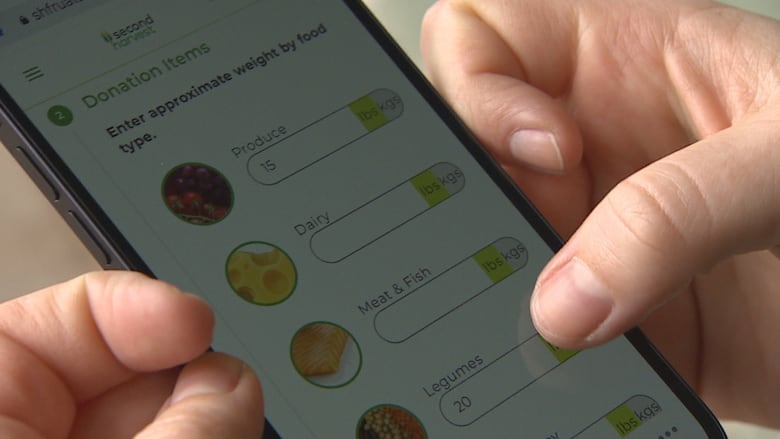P.E.I. Food Recovery Network uses app to connect donors and food programs
Program's goal is to reduce food waste as well as greenhouse gas emissions

Organizers of the new P.E.I. Food Recovery Network describe themselves as "matchmakers" for Island businesses that want to donate surplus food, and agencies that offer food support programs.
They've even created an app — not unlike a dating app — to connect donors and potential recipients.
The project is led by Second Harvest, which identifies itself as Canada's largest food rescue charity.
Operations program coordinator Emily Browning has been reaching out to local businesses that may have excess food in their operations.
"From warehouses, producers, farmers, all the way down to retail cafes, anywhere that there is food that is being wasted for whatever reason," Browning said.
"We want to make sure that we can rescue it and donate it and give it to different agencies in P.E.I. that distribute food to those in need."
There's an app
Browning said the app is an easy way to connect food donors with organizations offering food support programs.
"Basically, you say, I have 15 pounds [6.8 kilograms] of cheese to donate for whatever reason that may be. You set up a time that an agency can come and pick it up. You press post and then it notifies Island agencies within the kilometre radius that they have set," Browning said.
"If they have the capacity to come and pick it up during that window, they press claim and they show up, and they take the food, and distribute it to the clients that they serve."

Browning said it's important that the donation process be simple for businesses that want to participate.
"There are a lot of misconceptions about donating food. It's kind of understood to be a bit of an expensive endeavour, or it's hard to find an agency. It's time consuming. It's not necessarily the easiest thing," Browning said.
"What we really are aiming to do is make donation easy."
Browing said the app also makes it easier for the recipients.
"They like it because it's simple as well. They're notified when there's a donation. They know exactly what they're potentially picking up. They know where to go. All of the information is right there."

According to Second Harvest Canada, almost 60 per cent of food produced in Canada —about 35.5 million metric tonnes — is lost and wasted annually.
And of that, 32 per cent — or 11.2 million metric tonnes of lost food — could be salvaged and shared with people who need it.
It's really sad to hear how much food is going to waste, that is perfectly good, perfectly edible and should be distributed to the communities—Emily Browning, Second Harvest
Second Harvest said on P.E.I., the amount of food waste is more than 23 million kilograms every year.
"It's daunting. It's sad, really, because there are so many people that are affected by food insecurity," Browning said.
"There's rising prices at every front that's happening everywhere, and so it's really sad to hear how much food is going to waste, that is perfectly good, perfectly edible and should be distributed to the communities."

Expanding reach
So far, on P.E.I., the Food Recovery Network is working with 22 food donors to support 26 agencies, including the Community Fridge in Charlottetown.
"We've gotten over 6,000 pounds [2,722 kilograms] of food from their app. It also has helped us strengthen relationships with other businesses like Sobeys, for example," said Community Fridge co-founder, Samel Sunil.
"The app makes it easier for us because it's always there, every day maybe we will get a notification from them. It's always really good to get it, and we can fill up the fridge, and a lot of people use it, and it's just really helping everyone in the community."
It's always really good to get it, and we can fill up the fridge, and a lot of people use it—Samel Sunil, Community Fridge co-founder

Riverview Country Market in Charlottetown recently joined the P.E.I. Food Recovery Network.
Manager Trisha Viaene said the app makes it easy for the market to take the step toward donating their surplus produce, which until now has gone primarily to compost.
"It's sometimes just like minor mistakes on our part of ordering, or sometimes the supplier accidentally sends too much stuff," Viaene said.
"So it's like, let's get this food to people who need it, and deserve it, especially fresh food and not something that's just starting to go bad."

Reducing greenhouse gases
The Food Recovery Network receives funding from the Government of Prince Edward Island's Climate Challenge Fund, and Browning said reducing food waste is also connected to climate change.
"Food rescue is very heavily tied to also reducing greenhouse gases. When food is wasted, it usually goes to a landfill and in the landfills that emits greenhouse gases," Browning said.
"By diverting the food waste back into the hands of people in our community, we're also reducing the greenhouse gas emissions."
Browning said that between launching on Jan. 13 and the end of February, the Food Recovery Network rescued 60,455 kilograms of surplus food.
She said that represents a reduction of 227,328 kilograms of total greenhouse gases over that period.
Browning said Farm & Food Care P.E.I. and the City of Charlottetown are also partners in the Food Recovery Network.

